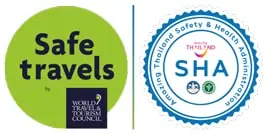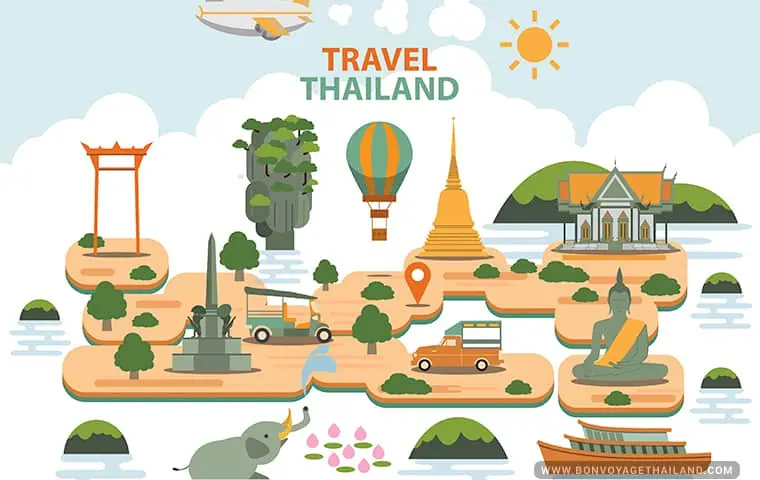
Welcome to our Ultimate Thailand Vacation Guide, your comprehensive resource for navigating this vibrant Southeast Asia gem. Known as the ‘Land of Smiles,’ Thailand captivates travelers with its rich history, diverse landscapes, delectable cuisine, and famously friendly locals. From the bustling metropolis of Bangkok to the ancient temples of Chiang Mai, the white-sand beaches of Phuket to the tranquil countryside of Chiang Rai, Thailand truly has something for everyone.
Whether you’re an intrepid adventurer, a culture enthusiast, or someone seeking relaxation, our guide equips you with all the necessary information to make your Thai journey unforgettable. We’ll delve into the nuances of the Thai culture, essential travel tips, culinary delights, must-see sights, and sample itineraries to inspire your travels. Pack your bags and get ready to explore the captivating charm of Thailand.
Understanding Thailand: A brief overview
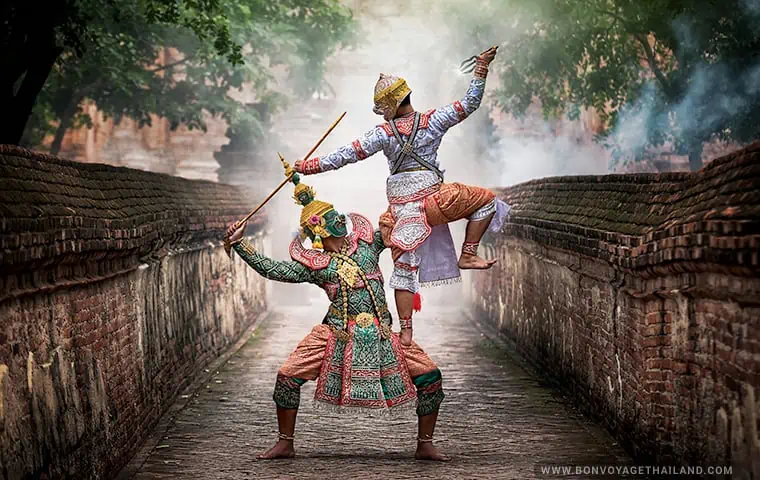
Thailand is famous for its breathtaking scenery, rich cultural heritage and hospitable people. Thailand is usually associated with its cheerful and warm-hearted people. This Southeast Asian country, officially recognized as the Kingdom of Thailand, features a long and captivating history, fascinating geographical features and diverse climatic conditions.
Nestled between Laos, Cambodia, Myanmar and Malaysia, Thailand is characterized by diverse landscapes. The mountainous regions of the north contrast sharply with the fertile plains of the central region, the high plateau of the northeast and the stunning beaches and islands of the south. Each region has its own charm and attracts travelers with different interests.
As for the climate, Thailand is tropical and is divided into three seasons: hot, rainy and cool. However, the weather patterns in the north and south differ slightly. In the north, cooler temperatures prevail from November to February, which is an ideal time for tourists to travel. On the other hand, in the south, which is near the equator, temperatures are relatively constant throughout the year, but the seasons are determined by varying rainfall. The east coast is best visited between January and March, while the west coast is most pleasant from November to February.
Originally, Thailand was home to ancient civilizations dating back to the Bronze Age. However, the country’s recorded history began with the founding of the Kingdom of Sukhothai in the 13th century. Sukhothai is considered the cradle of Thai culture, where the Thai alphabet and legislation were developed. In the following centuries, control passed to the Kingdom of Ayutthaya and later to what is now the Kingdom of Rattanakosin or present-day Thailand. These transitions have significantly influenced the country’s government and identity, enriching it with a fascinating web of histories, traditions, and architectures.
Knowing the different weather patterns of Thailand will help you better plan your itinerary. Whether you’re looking for a cultural trip to the ancient cities, a trek through the northern highlands, or a relaxing beach vacation on the southern islands, Thailand offers a unique and memorable experience for every type of traveler.
Stay tuned as we take a closer look at the aspects of Thailand that make it a must-see destination for globetrotters. This will help you plan the ultimate Thailand vacation.
Deciding When to Visit: Best Times for Thailand
Choosing the best time for your Thailand adventure depends on several factors, most importantly the country’s weather conditions and tourist seasons. The following guide will help you decide when to pack your bags and travel to the “Land of Smiles”
The Thai climate is divided into three distinct seasons: the hot season (March to June), the rainy season (July to October) and the cool and dry season (November to February). The term “cool” is relative, however, as temperatures average 26 °C during this time, making it a pleasant time for exploring.
The high season in Thailand coincides with the cool and dry season and lasts from November to February. During this time, temperatures are pleasant and there is hardly any rain, so you can explore Thailand’s picturesque landscapes and historical sites extensively. However, during the high season, expect larger crowds and higher prices for accommodations and flights.
The hot season, from March to June, is a mixed bag. It’s less crowded, so you get a more authentic picture of Thailand. Also, Songkran – the famous Thai New Year festival with city-wide water fights – takes place in April. But keep in mind that temperatures can rise to over 40°C, making sightseeing a challenge, especially in the midday heat.
Heavy downpours are common during the rainy season, or off-season, from July to October. This may sound off-putting, but this is also the time when Thailand is at its lushest and greenest. Tourist crowds thin out considerably and prices for accommodations drop, making this time suitable for budget travelers. Note that although the rains are often heavy, they usually only last for a few hours in the afternoon, so you can spend a lot of time in the dry.
The shoulder season – the months between the high and low seasons – is also a good time to travel. The weather is reasonably good, and with fewer tourists around, you can explore the area at your leisure.
The best time to travel to Thailand depends largely on what you want to do. For beach vacations and island hopping, the high season offers the best weather. If you want to explore the cultural sights or venture into the northern highlands, the cool season is the best choice. And if you’re looking for peace and quiet and don’t mind a little rain, the low season is perfect.
Remember that the charm of Thailand remains all year round. Regardless of the season you choose, the country will welcome you with its bright smile, delicious food and a wealth of experiences.
Thai Etiquette and Cultural Norms: Tips for Travelers

Thailand, often referred to as the “Land of Smiles,” is known for its friendly locals and rich cultural traditions. However, it’s important to understand and respect the customs to ensure a positive experience for both you and the locals. Below are some tips to guide you through Thai manners and cultural norms during your visit.
Respect the Royal Family and the Buddha: Thais have great respect for the Royal Family, and any insult, even unintentional, can result in severe penalties. Likewise, Buddha images and statues, regardless of size or location, are sacred in Thailand. It’s important not to pose with or climb on such objects.
Wai Greeting: In Thailand, people greet each other with a ‘wai’ – a gesture of pressing palms together in a prayer-like manner and bowing slightly. It’s a sign of respect, especially to elders. Foreigners aren’t expected to do this, but the return of a wai is appreciated.
Respect Temples and Dress Appropriately: Temples or ‘Wat’ are sacred places in Thailand. Dress modestly when visiting and cover your shoulders and knees. Remove your shoes before entering the main hall of the temple. Also, never point your feet towards the Buddha statues as this is considered disrespectful.
Support Local and Eco-Friendly Businesses: Opt for locally owned accommodations, eat at local restaurants, and buy from local artisans and vendors. By doing so, you’ll not only immerse yourself in Thai culture, but also contribute to the local economy. Wherever possible, choose eco-friendly options to minimize your impact on the environment.
Elephant Sanctuaries: Elephants are a symbol of Thailand, but unfortunately they’re often mistreated in the tourism industry. Choose to visit reputable elephant sanctuaries that prioritize animal welfare over entertainment. Do your research and choose an ethical tour with a sense of proportion.
General Behavior: Thai culture is non-confrontational. Courtesy, modesty and respect are emphasized. It’s frowned upon to raise your voice or show anger in public. Always smile and remain calm, regardless of the situation.
As a traveler, knowing and respecting Thai etiquette and cultural norms won’t only add to your experience, but will also have a positive impact on the international tourist community. Get involved in the local communities, appreciate their way of life, and leave a positive impression that will last beyond your stay.
Ensure your safety in Thailand
Although Thailand is generally safe for tourists, as with any destination, it’s important to remain vigilant and aware of potential risks. Here are some measures you can take to ensure your safety during your Thailand vacation.
Avoid petty theft: Petty theft and pickpocketing can happen, especially in busy tourist areas. Always watch your belongings, use the hotel safes for your valuables and be aware of your surroundings.
Respect Thai laws: Thai laws may be different from those you’re used to. Always abide by them, whether they’re drug laws (which are particularly strict), traffic rules, or public decency.
Avoid street demonstrations: Although not common, street protests may occur and are best avoided for your own safety. Always check the local news for the latest situation.
Travel Insurance: Purchasing comprehensive travel insurance is a must. It should cover medical emergencies, trip cancelations, loss of valuables and more. It’s a safety net that can be of great help in unfortunate situations.
Respect for Locals: Respect for the locals and their culture contributes greatly to a harmonious experience. Being polite and understanding cultural norms can enrich your trip and prevent misunderstandings.
Remember that your safety comes first. The Thai people are known for their hospitality and warmth, and with sensible precautions you can fully enjoy all that this vibrant country has to offer.
Navigating the Thai Currency: A Beginner’s Guide
When traveling in Thailand, you’ll use the Thai baht (THB), which comes in both bills and coins. Bills include the 20 (green), 50 (blue), 100 (red), 500 (purple) and 1,000 (gray) baht bills. Coins come in 1, 2, 5 and 10 baht denominations.
To keep track of current exchange rates, you should use the XE Currency Converter app. Take both cash and cards with you, as smaller, rural establishments may only accept cash.
It’s advisable to carry a mix of cash and cards. ATMs are widely available, but smaller facilities, especially in rural areas, may only accept cash. Remember that knowing the local currency isn’t only useful for transactions, but also helps ensure that you don’t get ripped off.
Knowing the local currency will ensure smooth transactions and prevent you from being shortchanged.
Health advice and vaccinations for Thailand
When traveling to Thailand, certain vaccinations can protect your health. Routine vaccinations such as tetanus, measles and mumps should be current. The most important vaccinations for Thailand include:
- Hepatitis A and Typhoid: To protect against foodborne illness.
- Hepatitis B and rabies: Consider these vaccinations if you’re exploring rural areas or anticipate animal bites or medical procedures.
Malaria occurs in some regions, so ask your doctor for advice on malaria prevention.
This advice is general in nature. Therefore, visit your local travel clinic in your home country at least 6-8 weeks before departure for individual health advice.
Staying Connected: Internet and SIM Cards in Thailand
In today’s digital age, it’s imperative to stay connected while traveling. Here’s your guide to staying online during your trip to Thailand.
Free WiFi hotspots: Many restaurants, cafes and shopping malls offer free WiFi. This is a convenient way to stay connected, but speeds can be inconsistent.
Local SIM cards: Purchasing a local SIM card is one of the most cost-effective ways to stay connected. You can purchase them when you arrive at the airport from service providers such as 7/11, AIS, DTAC and TrueMove. SIM Cards are inexpensive, and monthly subscription plans offer extensive data packages. The process is simple: select your plan, present your passport for registration, and you’ll be up and running in no time.
AIS: Among telecommunications providers, AIS is highly recommended for its comprehensive coverage and reliable service.
Co-Working Spaces: For digital nomads who need stable high-speed internet, co-working spaces are a good option. They’re widely available in major cities such as Bangkok and Chiang Mai.
Staying connected in Thailand is relatively easy and affordable. Consider what you need and choose the best option for your situation.
Remember that while it’s important to stay connected, don’t forget to disconnect and immerse yourself in the rich Thai culture that the Land of Smiles has to offer.
Transportation: Public transportation and other options
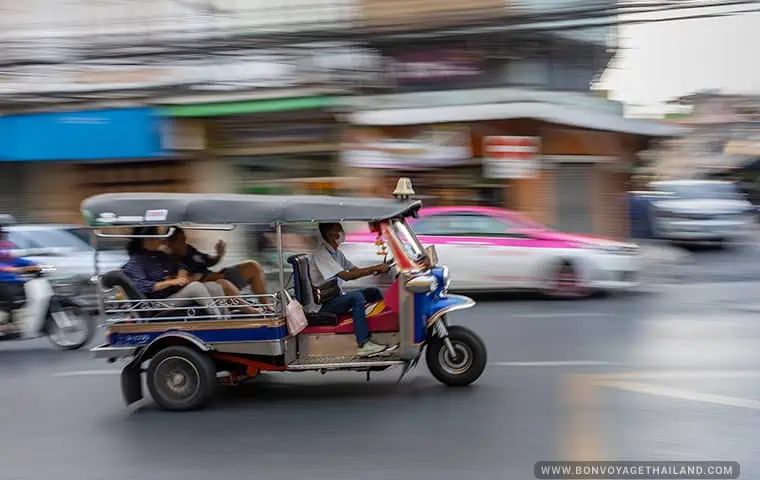
Thailand has a variety of transportation options that make it easy for travelers to explore this diverse country. Here’s an overview of the most commonly used modes of transportation and how to get around in them.
BTS Skytrain: In Bangkok, the BTS Skytrain is a convenient and fast way to get around. It runs from 6:30 in the morning until midnight and costs between 15 and 60 baht depending on the distance.
Busses: Busses are an inexpensive way to travel longer distances or between cities. They range from local city busses to luxury busses VIP for long trips.
Taxis: Taxis are plentiful, especially in cities like Bangkok and Chiang Mai. Be sure to turn on the taxi meter at the beginning of the ride to avoid overcharging.
GRAB: Similar to Uber, GRAB is a ride service app that is widely used throughout Thailand. It offers convenience, especially in places where cabs are less common.
Tuk-Tuks: These iconic three-wheeled vehicles are a fun way to travel short distances. However, agree on a price before you ride, as tuk-tuks don’t operate on a taximeter.
Car rental: Renting a car offers flexibility, especially for exploring remote areas. International driver’s licenses are accepted, but be aware of Thai traffic rules and conditions.
Each mode of transportation offers unique advantages. Assess your needs, destinations and budget to find the best fit for your itinerary.
Shopping in Thailand: Tips and Suggestions

From bustling night markets to upscale malls and bespoke tailor shops, Thailand is a shopping tourist’s paradise. Below are some tips for your shopping trip in this shopping wonderland.
Markets: Markets are an essential part of Thai culture. The Chatuchak weekend market in Bangkok, the Night Bazaar in Chiang Mai or Walking Street in Pai offer a huge selection of products, from clothes to handicrafts to street food.
Shopping malls: For an air-conditioned shopping experience, visit shopping malls such as Siam Paragon, CentralWorld or MBK in Bangkok. Here you’ll find everything from high-end brands to local designers and electronics.
Street Vendors: When looking for unique and affordable items, a visit to the street vendors is a must. Remember to haggle – it’s a common practice and can help you get a better deal.
Tailored clothing: Thailand is known for its excellent and inexpensive tailor shops. Allow plenty of time for fittings and customization.
Counterfeit goods: Be wary of counterfeit goods, especially branded items. If the offer seems too good to be true, it probably is.
With a little smart shopping, you can ensure that your shopping trip to Thailand is enjoyable and fruitful. After all, what would a vacation be without a few souvenirs to take home with you?
Communicating in Thailand: A Brief Thai Language Guide

Communicating effectively with locals can enhance your travel experience. Although English is spoken in many tourist areas of Thailand, here are some basic Thai phrases and norms that can help you.
Greetings: The traditional Thai greeting or ‘wai’ consists of a slight bow with palms together. Accompany it with “Sawasdee” followed by “Khrap” if you’re male, or “Kha” if you’re female.
Politeness: Thai people place great emphasis on politeness. Adding “Khrap” or “Kha” at the end of sentences shows respect. For example, “Thanks” is translated as “Khob Khun Khrap” (for men) or “Khob Khun Kha” (for women).
Gender-specific pronouns: The Thai language uses gender-specific pronouns. Men usually refer to themselves as ‘pom’ and women as ‘di-chan’, especially in formal conversations.
Friendly Manners: Smiling is an important part of Thai communication. It reflects friendliness and helps create a positive interaction.
Knowing some basic knowledge of the Thai language and its norms can make your interactions with locals more pleasant and respectful. A small effort to understand the language can greatly enhance your travel experience in Thailand.
Exploring Cuisine: An Introduction to Thai Food
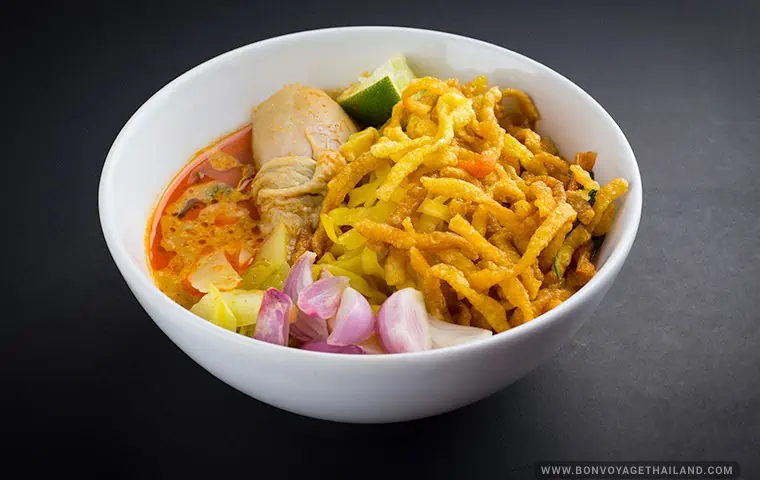
Thai cuisine is a vibrant fusion of flavors that makes it a culinary adventure for any food lover. Here is a brief introduction to guide you on your culinary journey.
Popular dishes: Iconic Thai dishes include Pad Thai (fried noodles), Tom Yum Goong (spicy shrimp soup) and Green Curry. Each dish features a unique blend of sweet, sour, spicy and umami flavors.
Street food: Street food is a cornerstone of Thai culture. When eating, prefer stalls with high turnover and freshly prepared food to be safe.
Must-Try Dishes: There are countless dishes to try, but Som Tam (spicy green papaya salad), Massaman Curry and Mango Sticky Rice aren’t to be missed. Adventurous people should try local specialties like durian fruit or yam salads from the street.
Thai cuisine is a journey through a landscape of unique flavors and dishes. Enjoying local cuisine is an indispensable part of your Thailand experience.
Accommodation in Thailand: From Budget to Luxury
Thailand offers a wide range of accommodations for every budget and travel style. Here is an overview of what you can expect.
Budget accommodations: Budget travelers will find numerous hostels throughout Thailand. These offer a great way to meet other travelers while keeping costs down. Look for well rated hostels with amenities like free WiFi and breakfast.
Middle-class accommodations: Airbnb and guesthouses offer more comfort and privacy. They range from basic apartments to unique local accommodations, with prices varying by location and amenities.
Luxury accommodations: For those who want to spend a little more money, luxury resorts, especially in areas like Phuket or Koh Samui, offer exquisite service, beautiful architecture, and idyllic beach views.
Accommodation options in Thailand are suitable for all travelers. Whether you’re looking for the atmosphere of a shared hostel, the comfort of mid-range Airbnb accommodation, or the opulence of a luxury resort, you’ll find what’s right for your stay.
Activities and Attractions: Chiang Mai, Chiang Rai, Bangkok Highlights
Thailand is full of vibrant cities, historic sites and exciting activities. Here are the must-see attractions in Chiang Mai, Chiang Rai and Bangkok.
Chiang Mai
- Doi Suthep Temple (Wat Phra That Doi Suthep): This temple is one of the holiest in Thailand. It’s perched on a mountain and offers a panoramic view of the city.
- Elephant Sanctuaries: Visit an ethical elephant sanctuary where these majestic creatures are rescued and cared for. Make sure it’s a genuine sanctuary where the animals’ welfare is paramount.
- Cooking Classes: Immerse yourself in Thai cuisine by attending a cooking class. Learn how to prepare local dishes using ingredients from an organic garden.
- Adventure Activities: For thrill seekers, ziplining through the jungle or whitewater rafting on the Mae Taeng River are a must.
Chiag Rai
- White Temple (Wat Rong Khun): This unique all-white temple is an artistic masterpiece filled with symbolic Buddhist and Hindu images.
- Blue Temple (Wat Rong Suea Ten): Marvel at the stunning blue interior of this modern Buddhist temple, decorated with intricate carvings and paintings.
Bangkok
- Grand Palace & Wat Phra Kaew: Visit the city’s most famous landmark, a complex of beautiful temples including the Temple of the Emerald Buddha.
- Floating Markets: Experience the vibrant atmosphere of Bangkok’s floating markets. Sample local food, buy souvenirs and enjoy the unique surroundings.
- Things to do in Bangkok: Discover the contrasts of Bangkok, from majestic temples to ultra-modern shopping malls, and enjoy the delights of street food in the vibrant heart of the city.
From historic temples to exciting outdoor activities and immersive cultural experiences, these cities offer countless opportunities to immerse yourself in Thailand’s rich culture and natural beauty.
Planning your itinerary: sample itineraries
Thailand’s diversity offers endless possibilities for your travel planning. Here are sample itineraries that combine cultural immersion, adventure and relaxation in Chiang Mai, Chiang Rai, Bangkok and Phuket.
Cultural Discovery (7-10 days)
- Days 1-3: Start in Bangkok and visit the Grand Palace, Wat Phra Kaew, and explore the lively floating markets.
- Days 4-6: Travel to Chiang Mai. Visit Doi Suthep Temple, take a cooking class and spend a day at an ethical elephant sanctuary.
- Day 7: Travel to Chiang Rai and explore the White Temple and the Blue Temple.
- Day 8-10 (optional): Add a few days to your trip to visit the ancient ruins of Ayutthaya and Sukhothai.
Adventure & Relaxation (10-14 days)
- Days 1-3: Start in Chiang Mai with a visit to Doi Suthep, then go ziplining or white water rafting.
- Days 4-6: Explore the temples of Chiang Rai before taking an overnight train or short flight to Bangkok.
- Days 7-9: Experience the energy of Bangkok, visit the Grand Palace, Wat Phra Kaew, and take a boat tour on the Chao Phraya River.
- Days 10-14: End your trip relaxing on the beautiful beaches of Phuket, with optional island hopping to the Phi Phi Islands or James Bond Island.
These itineraries offer a balanced mix of activities, but you can customize them to suit your interests. Thailand has much to offer, and any trip here promises to be an unforgettable experience.
Can I drink the tap water in Thailand?
The health of travelers is paramount, and when it comes to drinking water in Thailand, it’s best to be safe than sorry.
Although tap water in Thailand is treated and technically safe, it can still contain certain bacteria and contaminants that can spoil your stomach. Therefore, it’s generally recommended not to drink tap water.
Instead, opt for bottled water, which is readily available and inexpensive throughout the country. Also, when buying bottled water, make sure the seal is intact so you don’t have to buy a refilled bottle.
Ice in drinks can be a problem, but most restaurants and bars make it from purified water. However, if you’re unsure, it’s always safer not to ask for ice in your drinks.
Adequate hydration is very important in Thailand’s tropical climate, but it’s equally important that the water you drink is safe.
Major Airports in Thailand
Thailand’s well-developed airport network makes it easy to explore the country. Here are the main airports you might use on your trip:
Suvarnabhumi Airport (Bangkok): As Thailand’s largest airport, Suvarnabhumi serves numerous international and domestic flights daily. The airport is about 30 km from the center of Bangkok and offers various transportation options such as cabs, busses and the Airport Rail Link.
Don Mueang International Airport (Bangkok): This airport, which is mainly served by budget airlines, is one of the oldest airports in the world. It is located about 24 km north of Bangkok city center and is accessible by busses, cabs, and an upcoming rail link.
Chiang Mai International Airport (Chiang Mai): This airport is the main gateway to northern Thailand and is used by several airlines for domestic and international flights. It is located only a few kilometers from the city center and can be reached by cabs and songthaews (shared cabs).
Phuket International Airport (Phuket): A gateway to Thailand’s popular beach resorts, it offers numerous domestic and international flights. The airport is about 32 km from Phuket town. Cabs, buses and shuttle services are available for transportation.
These airports make traveling in and out of Thailand convenient and facilitate your journey through this enchanting country.
Wrapping Up Your Thai Adventure: The ultimate Thailand vacation guide
And there you have it – our comprehensive guide to an unforgettable vacation in beautiful Thailand. From the heartwarming smiles of the locals, to the vibrant city scenes, to the tranquil landscapes, Thailand offers a variety of experiences to suit every traveler’s taste.
Whether you visit the country for its rich history, exotic cuisine, impressive temples, bustling markets, stunning beaches or all of the above, Thailand always leaves a lasting impression. Remember, this guide is only a starting point. The true charm of Thailand lies in its unpredictability and the spontaneous moments of happiness you’ll undoubtedly experience during your trip.
So immerse yourself in the culture, be respectful of the country and its people, and above all, enjoy the adventure. Prepare to make memories in the Land of Smiles that you’ll cherish for a lifetime. Have a great trip and enjoy your Thailand adventure!
